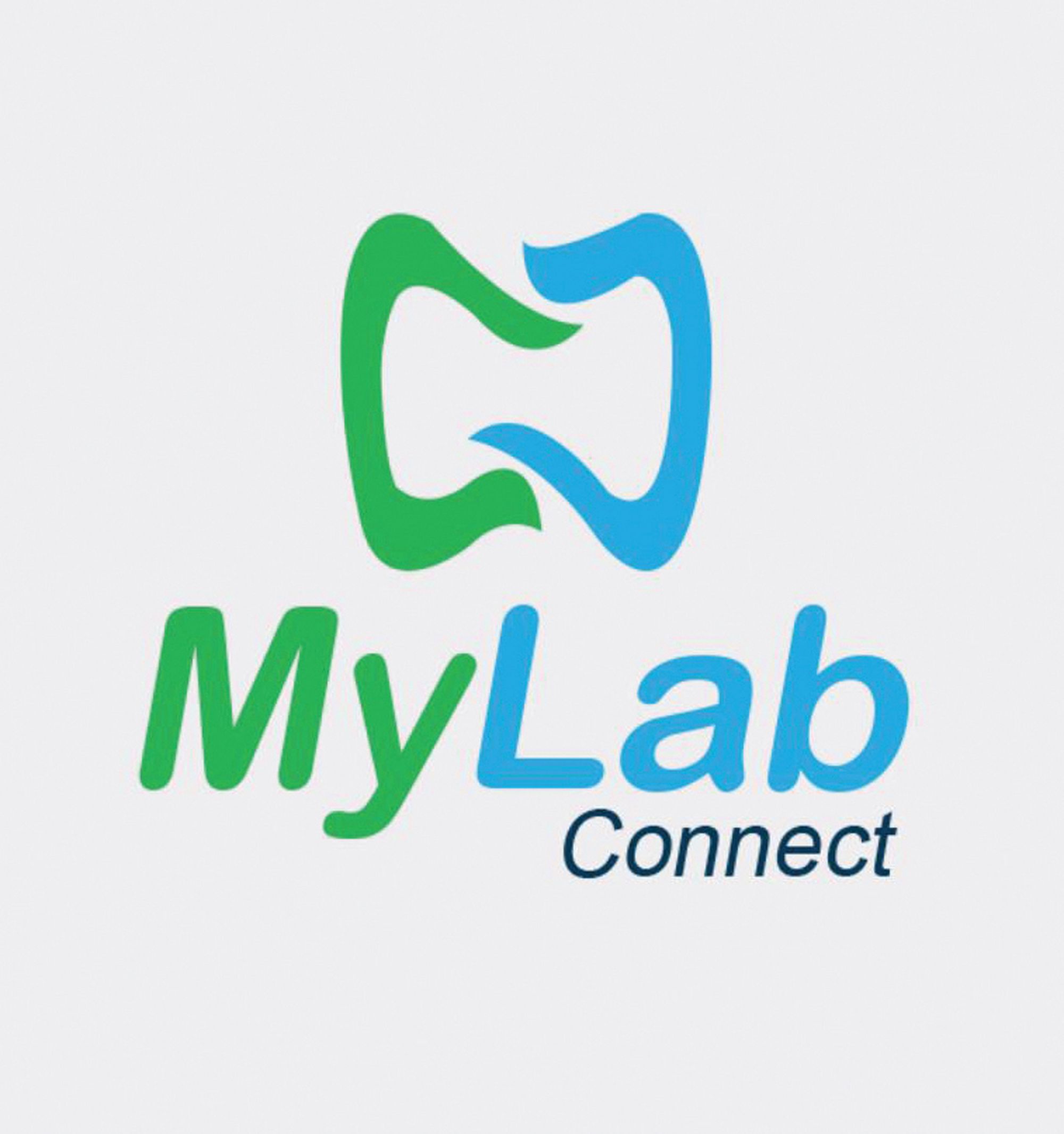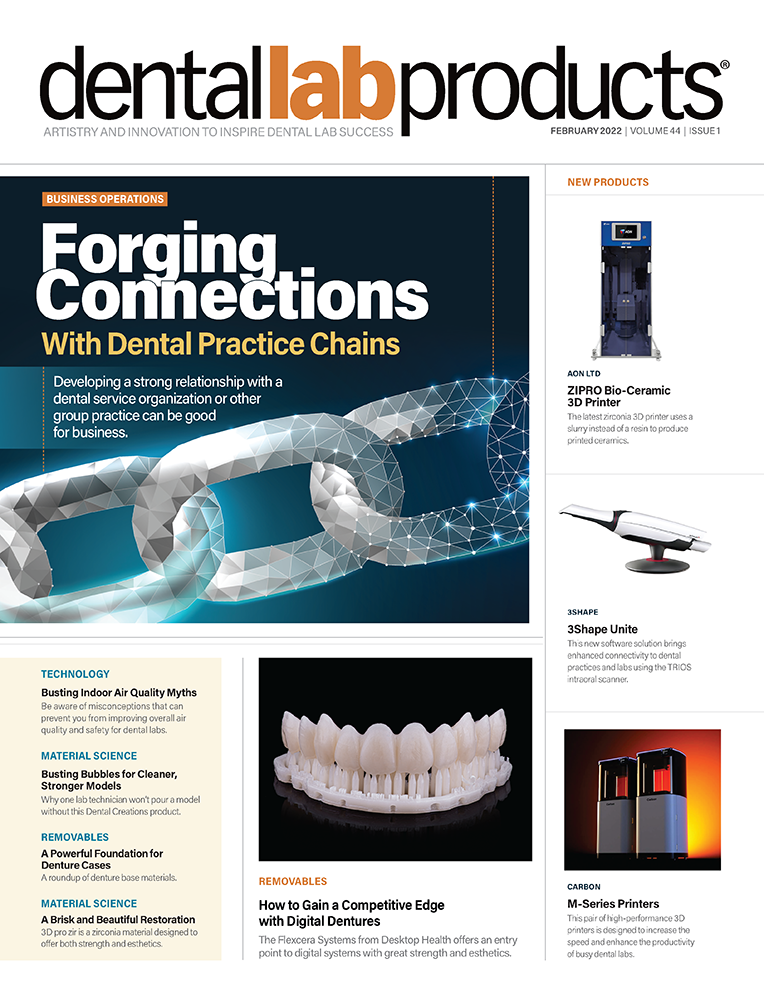The goal of any business is to make money. Sure, there are some businesses where social responsibility is important, but ultimately, businesses are in business to make money—and that includes dental labs. There are a lot of factors that go into making money. Labs need to be efficient at what they do, maximizing profits. Taking on larger and larger clients is an avenue toward generating more income, and dental service organizations (DSOs) can provide that work. But labs must be able to deliver what DSOs want.
Important Considerations: Opportunity and Necessity
For some labs, forging a relationship with a DSO is not only desirable, but it’s critical for business success.
“We’ve seen the DSO space grow consistently over the past decade or so,” Jamie Stover, CDT, says. He is the senior manager of dental lab applications at Carbon. Having been a dental lab technician for more than 23 years, and COO of a successful lab prior to his current role, he has managed relationships with many DSO accounts.
“The trend of solo practitioners joining groups is expected to continue. The 2021 NADL Business Survey shows us that about 80% of labs report they’re now working with clients from the small to emerging group practice segment—dental groups in the range of 2 to 15 or 20 offices.”
DSOs come in all sizes. One may think of them as being organizations with dozens, if not hundreds, of locations, but the DSO could be as small as 10, 5, or even 2 practices.
“Eighty percent of the labs in the survey reported that they’re working with the smaller groups and about 40% report that they’re working with larger DSOs,” Stover says. “When we ask if it’s a good idea for labs to seek out a relationship with DSOs, the answer is ‘Yes’—when it’s done strategically. And according to the NADL survey results, the majority of labs report that dental groups, ranging in size from small to large, represent some percentage of their overall client base, so it appears that having a DSO strategy is a necessity.”
From the DSO’s perspective, lab partners must be able to meet the specific needs of DSO partners.
What is the DSO interested in when they seek out lab partners? It depends on the DSO, where they are located, and what they need in their specific business structure.
For instance, Chris Salierno, DDS, chief dental officer for DSO Tend, explains why they work with numerous labs.
“We work with several,” Dr Salierno says. “At the close of 2021, we have 19 locations in 4 markets (New York, New York; Washington, DC; Boston, Massachusetts; and Atlanta, Georgia). We appreciate laboratories that can scale with us, but we also partner with at least 1 local laboratory in each market. We value the ability to have services like shade selection and emergency turnaround services.
“Dr Marc Schlenoff, Tend’s vice president of clinical development, is a master of comprehensive and esthetic dentistry,” Dr Salierno continues. “He is in charge of our laboratory relationships. When we enter a market, we listen to our dentists about their preferred laboratory partners. Dr Schlenoff creates a mixture of options based on our national and local partners that meet his standards.”
Pursuing a relationship with a DSO comes with some caveats. The relationship may not be a fit for everyone. For instance, Jack Marrano, CDT, director of Absolute Dental Services’ Signature Prosthetics Division, explains why he does not actively seek such affiliations.
“It’s not an area of work that I’m interested in at this time,” Marrano says. “They are not my targeted clients. A lot of that has to do with the fact that DSOs are exceptionally price conscious and we do not negotiate price. With DSOs, you’re working on a much tighter margin. There is a considerable amount of logistics that go into working with a DSO.
“Once an account of that size is brought on board, it becomes a constant risk. You could very easily create a situation where, no matter what, you can easily become beholden to a DSO. In this situation, it can become a risk. So, to lose that account would be absolutely devastating, the loss of such an account of that size would definitely have a very negative impact on your organization.”
That scenario may not necessarily be the case for bigger labs.
“The bigger laboratories and the big lab groups primarily deal with the DSOs,” Marrano says. “Maybe structure-wise they’re a little bit more set up for it. Absolute, by no means, is a small organization, we do have 1 local large DSO group, but that is a long-standing relationship that the owners have had in which both companies have grown with a mutually beneficial relationship.”
Putting the Right Foot Forward in the Door
Dental labs attract DSO clients as they would any other client.
Just because the DSO is a larger client doesn’t mean that their needs are fundamentally any different.
“There are so many services a lab can offer, aside from the obvious crowns, bridges, and dentures—those have to be on-point,” Marybeth Starr, director of brand experience for Harvest Dental Products, says. “If you are trying to attract a large client, it makes sense to offer white-glove services, for example a dedicated representative as a point-of-contact, someone who knows their account inside and out.
“Also, our industry is made up of entrepreneurs. Highlighting what makes you different can go a long way to building a relationship,” she says.
Seeking out potential DSO clients to partner with takes a bit of finesse and networking.
“It’s definitely not as simple as doing a Google search for DSOs, making a list, and cold calling them.” Stover says. “There are a couple really effective ways to connect with group accounts.
“The simplest and most efficient way, in my experience from a marketing and budgeting standpoint, is to leverage relationships with existing solo dental clients who join a group. Often, labs will fear losing a client to a DSO, when they actually should see a client joining a group as an opportunity to forge a relationship with that group as one of their lab providers, a foot in the door so to speak,” Stover says.
“A dentist client who joins a group can become a really strong internal advocate for your lab, because they’ve had a working relationship with you and they trust you,” he continues, “and their evangelism can jump you to the front of the line of the labs who are pitching the DSO to become a lab vendor.”
Opportunity also exists when DSOs get together at conferences and shows. Attending and introducing the lab is another good way to get the lab’s name out there.
“Regional DSO conferences are a great opportunity,” Stover says. “Either by paying to be a featured vendor and having a booth or as a conference attendee, to network and attend some of the same courses, and just observe what the DSOs are focused on and learning about. I don’t actually recommend a lab attending as a vendor until they have a really solid DSO business plan in place, and also they should have a few group accounts already as customers.
“Experience in the DSO space establishes credibility and legitimacy,” Stover continues. “When I was in the lab and overseeing our DSO business expansion and our DSO business strategy, it was very common, when having a conversation with a decisionmaker from a dental group, for them to ask me, ‘Who are some other groups you currently work with?’”
DSOs Value the Right Technology for the Best Outcomes in the Lab
Technology, in one form or another, has always been a hallmark of dental lab work. Three hundred years ago, it was finding the best animal teeth to fabricate dentures. In 2022, it’s the right hardware, software, and cloud infrastructure to deliver optimized CAD/CAM solutions.
The lab’s ability to work with current technology is critical if they hope to work with DSOs.
“The vast majority of our cases are digital impressions, so we need a laboratory that can accept this data in a HIPAA [Health Insurance Portability and Accountability Act]-compliant fashion” Dr Salierno says. “And we’re continually innovating, so we value the ability to pilot new workflows with our lab partners.”
“Technology is huge,” Starr adds. “Labs have to have access to it. If they don’t have the latest and greatest technology in the lab, there are so many good products/processes out now, chances are they know someone who does. Partner up and work together to service the customer. Shine a light on your technicians and highlight their experience. Ensure that the points of contact on both sides are introduced to each other.
“The people having the day-to-day interactions need that connection to start building a relationship, while at the same time the owner will be building a relationship with the decisionmakers in the practice,” Starr continues. “Have a plan to scale, look for outsource partners for overflow work. It’s amazing to get the big account, but you have to be able to service them and make sure they know that you have everything covered.”
Within the lab, cutting edge technology streamlines workflows to ensure that cases are created and delivered as efficiently as possible.
“On the laboratory side, you would have to make sure that you have the capacity and proper systems in place, and that spans a wide area,” Marrano says. “It could be mills. It could be printers, but it could also be your internal systems and processes to deal with large volumes of digital data. We have developed a HIPAA-compliant web portal for clinicians to easily upload any data they may have. Today’s lab must make it convenient for clients to do business with them.
“For groups that are tech savvy, then you definitely want to make sure that you’re well versed in intraoral scanning with all of the systems, because we get calls every day from our clinicians and they have questions,” Marrano continues. “Data collection and organization play a big part in today’s lab. The lab must be able to organize cases and case info coming into the laboratory in a new way. It is important to be a solutions-focused laboratory. We have a team that specializes in both clinical and technical digital workflows, and they support those incoming calls.”
Technology isn’t just necessary for workflows within the lab. It’s vital to process cases—and streamline communication—with individual practices.
“Technology is extremely important,” Stover says. “It’s just an extremely important piece of the puzzle in the DSO space because it streamlines the workflow between the lab and the clinics. Technology allows labs to transition from analog to digital processes, which means they can produce restorations that have a lot of benefits for clinicians and patients, like reducing the number of appointments and reducing the chair time required.
“It also reduces the amount of analog labor required by the lab to produce many restorations and allows them to scale production to keep pace with the increased volume of work without increasing the need to hire as many experienced technicians—3D-printed dentures and splints are a couple examples of how labs are doing this,” he continues. “Labs printing dentures versus producing them at the bench by hand can reduce their labor by up to 65%, and they can reduce the number of clinical appointments required for the dentist to 3 or 4 versus 5 or 6.
“If you have 15 offices in a DSO, and each office does 1 or 2 denture cases per day, and you’re saving them 2 to 3 appointments over the course of those dentures being delivered per office, that adds up to substantial annual savings,” Stover continues. “Also, when labs can produce restorations digitally and lower their production costs, it allows them to pass along some of those savings to the DSO in the form of lower retail pricing and still maintain acceptable profit margins. When thinking of the increased scale that dental groups operate at, anything that simplifies the workflow and the communication—or saves them chair time, or requires fewer patient appointments, anything like that—it’s going to save the offices money, and that’s going to be a metric multiplied by the number of offices they have.
“If a lab can help a DSO be more profitable by saving them time, it’s going to be a lot more valuable than a lab who can only provide line-item discounts on statements and low, cut-rate prices on restorations,” Stover says.
Within the discussion of technology, one shouldn’t overlook materials and what they bring to the lab’s value.
“There are new materials coming out all the time,” Starr says. “This is where our foundations, journals, and trade shows come in—use them, read them and stay up-to-date on anything new. Be the first one to bring something that you think is interesting and helpful to the practice, but do your research. Go in with full knowledge and a plan for how and why you think it will benefit the group.
Knowing What’s Best for the Lab
While creating a relationship with a DSO can be a huge boost for a lab, it’s important to be discerning in this process and take time to consider the options. Here are a few questions to ask before forging a relationship with a DSO.
- Will there be open lines of communication? While it may have been easy to get in touch with the dentist, will it be as easy with a potential new manager? It is important to consider one’s relationship to the practice owner and how that may change going forward with the DSO.
- Do you have the manpower to build that strong foundation? Is there enough money to specifically allocate to forging this relationship? Designating a person to be that point-of-contact may take them away from another position, and hiring a new person altogether comes with its own sets of challenges.
- Are you on top of new technology? DSOs want to see the best of the best, so even if you may have all of the tools, you might not have the specific advancements they are looking for in their practices. Not having the right equipment may convince a DSO to take its business elsewhere.
“The dental industry has embraced teledentistry in the last 2 years and it is only going to continue to grow—it is allowing practices to increase patient volume back to pre–COVID-19 levels,” she continues. “Part of a lab’s offering can be to present on telehealth video conferences for care planning on complex cases. This gives a video recording of the plan and is a huge time-saver for everyone involved.”
In addition to hardware, software is a critical component to a CAD/CAM workflow, especially as communication with client practices is concerned.
“One thing we don’t think about a lot is software,” Starr says. “If you know what software the practice uses, many have ‘lab versions’ that can interface with the big dental software. This makes it easier to transmit pictures, patient files, etc., and they are HIPAA compliant.”
Don’t Make These Common Mistakes When Connecting to the DSO
One of the best ways to learn how to do something is to benefit from the wisdom of those who have already tried and made mistakes.
“When it comes to working with DSOs, I’ve made some missteps,” Stover says. “A common misstep is labs propositioning DSOs that are of a size and scale beyond that lab’s production capability and really beyond the scope of services that the lab can provide. In other words, you could say biting off more than they can chew. The largest DSOs leverage their immense size and volume of work to drive restoration prices down to levels that some labs just can’t deliver and still maintain adequate profit margins, without cutting too many corners.
“And when you cut those corners, when producing restorations, it quite often, unfortunately, means that the fit of the restorations is affected or the turnaround time is affected,” he continues. “As a lab, you start to drop the ball because of the increased volume of work. Every system in the lab’s workflow becomes strained, and small production issues become large ones quickly. That creates a very frustrating situation for the groups and the lab.”
Stover says that the plan is the most important part.
“This goes back to my previous point of having a really solid DSO business plan in place before going after work from the larger DSOs,” Stover says. “But having that plan in place before working with groups of any size is important.”
Connecting Through Open Communication and Collaboration
Labs should also have a point person who is solely responsible for servicing those clients.
“Another misstep is not having a dedicated DSO account customer service rep at your lab to manage your group accounts,” Stover says. “Labs really need to dedicate some resources to this segment of their customer base if they’re going to be successful, because dental groups have unique needs, and working with DSOs will really strain the customer service resources of most labs. A dedicated DSO liaison can oversee those group accounts, from onboarding offices to managing the day-to-day case issues that arise.”
“Not mistakes, just think big with technology and selective outsourcing any size lab can make this happen,” Starr says.
Understand what potential client DSOs want—pitching one’s lab, but highlighting the wrong things, is a surefire way to lose an opportunity.
“Whether you’re working with a large group practice or a solo operation, it’s most important that you are aligned with their needs,” Dr Salierno says. “Tend dentists want to provide comprehensive, high-end dentistry to urban populations; if a lab were to pitch us on how inexpensive they are, they would be missing the boat.”
Forging a relationship with a DSO can be great for one’s business. Assuming the lab is able to deliver to its DSO clients efficiently and productively, connecting with a DSO can be great for business, but making that initial connection requires having what potential DSO clients need, and ultimately, being able to deliver on those promises.





